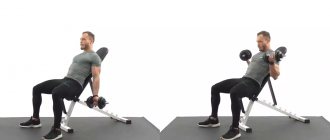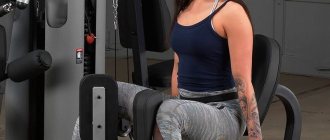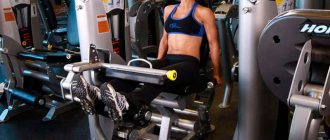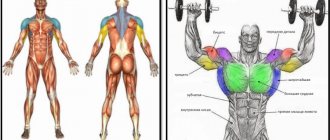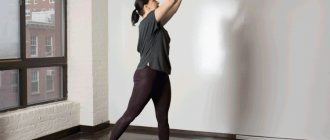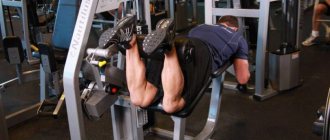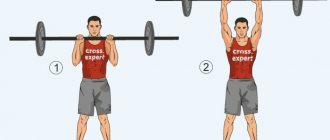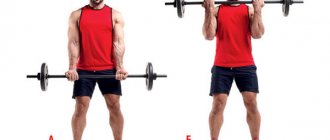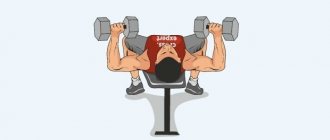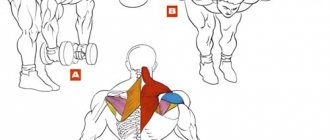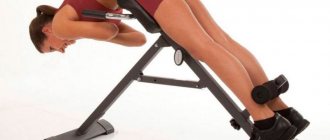Standing or seated calf raises are traditionally used in fitness and bodybuilding to train the calf and soleus muscles. The exercise is universal and suitable for both beginners and experienced athletes. Calf raises can be performed with a variety of equipment in the gym or at home.
The effectiveness of this calf exercise essentially depends on two key parameters:
- Range of motion of the ankle joint. In order for this amplitude to be greater, when performing the exercise, the toes of the feet are placed on a barbell plate or any other platform. Thus, the heel drops lower, muscle stretching increases and the load increases.
- The weight used. The weight is chosen so that you can do 10-12 repetitions cleanly with it.
Benefits and disadvantages of exercise
The calf raise exercise is a universal movement that includes a large number of execution options. It can be done in a variety of styles, increasing both endurance and strength. Also, calf raises with dumbbells are considered the main “mass-building” exercise, so if you exclude them from the training program, you should not expect an increase in the volume of your calves.
Benefits of calf raises:
- Pumping the calf and soleus muscles (the focus of the load changes with the position of the legs).
- Ability to work in different modes: multi-repetition, strength, with or without weight.
- Significant increase in pushing power and improved performance in all types of jumps.
- Reduced fatigue while walking and running.
- Creation of voluminous and embossed calves.
All the disadvantages of calf raises in a machine or with free weights are associated with incorrect execution of the movement. This includes choosing the right technique, maintaining proper technique, and intelligently integrating movement into the training regimen.
What muscles work
When performing calf raises while standing or sitting, the main load falls on:
- Calf muscle (both heads).
- Soleus muscle.
When working with weights, a number of muscles are involved in the work , which work in a static mode and are responsible for stabilizing the body:
- Core muscles.
- Spinal erectors.
- Thigh muscles (adductors, quadriceps).
- Gluteal (small and medium).
Difference in sitting and standing position
The position also determines which muscles work during movement.
- In a sitting position (when the leg is bent at a right angle at the knee), the soleus is predominantly loaded.
- In a standing position – calf.
Stop placement
Also, due to holding a dumbbell, the shoulders and trapezius are partially loaded.
Separately, the stereotype about leg positioning . Some athletes believe that changing the position (toes turned out or pointed inwards) of the feet can shift the load on certain muscles. However, this is an error that goes against basic anatomy. The position of the feet does not change the load on the calves. And besides, the position with the toes turned out or inward creates an increased load on the knee joints. Therefore, in any type of exercise, it is always recommended to do lifts with a standard position of the legs (toes pointing straight, feet parallel to each other).
How to end a workout correctly
After completing exercises for losing weight in your calves, it is important to do some stretching. Lunges help with this, which can be done as follows. Take a deep step with your foot, palms resting on the knee, and the leg remaining behind should feel a stretch in the lower leg. In this state there is a short delay. We return to the original position, the action is repeated for the other leg. There are several steps you can follow this way.
Also home exercises for legs
allow you to give your shins a small massage after training. Having finished massaging the calves, we proceed to rubbing them with a simple dry towel. This simple action will improve blood flow, which will have a beneficial effect on muscle tissue.
Standing calf raise in the machine
There are several variations of the exercise. Performing the movement while standing in the simulator is considered one of the most popular. It allows you to perfectly load the muscles, but creates additional stress on the spine. When working with heavy weights, this should be taken into account if the athlete has injuries or avoids compression effects on the vertebrae (associated with the pressure of the fixing rollers on the shoulders). In this case, it is recommended to do the movement while standing with dumbbells. This option creates much less compression and allows you to work with heavy weights without fear.
Technique:
- Set the desired weight on the machine. Stand with your toes on the platform and place the bolsters on your shoulders (hold them with your hands for extra support).
- Rise up on your toes at a moderate pace.
- Without pausing, lower yourself down (at a slower pace).
When using the machine, do not lower your heels too low for additional stretching. When working with heavy weights, this can lead to injury. The downside of all options in the simulator or with a standing barbell is the increased load on the spine. Therefore, in this technique it is much more effective to work in a high-repetition mode and with moderate weight.
The most useful type of calf raise machine is a device in which the body leans forward (imitating the old “Donkey” exercise). In this position, the calf muscles are maximally stretched, and the spine does not receive a compression load.
Nuances to consider
To make standing calf raises more effective, the following aspects should be taken into account when performing them:
To work this muscle group, you will need to perform from 3 to 5 approaches, which include 15-20 repetitions. It is recommended to use a medium weight, because if you overload yourself, it will be impossible to do a sufficient number of repetitions, and this is what determines the effectiveness of the exercise. But underweight will not load the muscles as much as necessary. Make sure that your back does not arch, and that your shoulders, pelvis and heels remain in line. Also, the head should not “nod”. All movements are concentrated in the ankle area. The muscles will receive an even greater load if the amplitude is maximum
You should strive to lower your heels as low as possible and raise your heels as high as possible. It is important to monitor proper breathing; if you forget about it, it will be more difficult to keep your spine straight. In order not to damage the tendons, it is necessary to lower smoothly, and the heavier the load, the more careful the downward movements should be. Lifting up can be more powerful and even sharp, the main thing is to tighten the lower leg muscles more strongly. Take a short break every time you reach the highest point
This stop creates additional stress. It is not necessary to linger at the bottom, but it can be done if at the same time you want to stretch your muscles. You shouldn't stop at the bottom if you're training with heavy weights.
Calf raise while sitting in the machine
When performing seated calf raises, the focus of the load shifts from the gastrocnemius to the soleus (which is located under the calves). Its training is considered a very important task, since this muscle is longer than the calf. It literally “pushes” the calves out and visually increases volume, creating a more massive look.
Technique:
- Sit in the exercise machine, place the edge of your foot on the platform. Place soft pillows on your thighs (at or just above your knees).
- Start pushing the weight up.
- Without pausing (at a slower pace), return to the starting position. Do not lower your foot below parallel to the floor.
When sitting, it is important to do calf raises without using your hands. You should not “pull” your legs up with your hands to lighten the load. Place your hands on the handles and keep your back straight.
Some features
To make the exercise more effective, you should use these tips:
- When performing the approach, keep your knees slightly bent and do not straighten them until the last moment.
- It is best to pause for two seconds in the finale. This is very difficult to do, but you will get the most out of your training.
- Initial approaches should be done with the greatest amplitude so that the peak of contraction and full extension are achieved. In the last approach, when it is impossible to do a single full repetition, repetitions should be done partially until complete failure.
- After the exercise is completed, you need to carefully stretch your legs.
- Advice for experienced athletes. When you change the position of your feet on the platform, it is possible to increase the load on the inner or outer heads of the calf muscles. When you point your toes out to the sides in relation to your heels, the heaviest load falls on the inner heads. When you bring your socks inward, the load goes on the outer heads.
The machine press is a great exercise for working your calves. Provided that you do it correctly and constantly, it is possible to gain muscle growth and improve performance.
The main mistake when performing this exercise is mobility in the knee joints. During the entire workout, you need to keep your knees in the same position. When this cannot be achieved, you need to use less weight.
Fully straightened knees are also considered a fault. In this position, the load falls entirely on the joints.
When the legs are in a standard position, then the load is placed evenly throughout the muscle. If your legs are in a wide position and your toes are turned outward, then the load falls on the inside of your calves. If the legs are in a narrow position and the toes are turned inward, then the load falls on the outer part of the calves.
Toe press video
The press is best used during specialized leg work; this is most often practiced by athletes with long legs. Problems with the triceps muscle are most often experienced by people with long tendons. Those who do not have problems with the lag of this muscle separately do not need to train it.
Calf raise in Smith
Not every gym has a special machine for performing exercises in a standing position. Therefore, raising your toes in Smith is a universal way to perform the movement, regardless of the conditions and equipment of the gym.
Technique:
- Set the bar to the desired height and place 1-2 plates on the floor (as a protruding platform).
- Place the bar on your shoulders and stand with the edge of your foot on the plates. The back is straight, hands are on the bar.
- Push off the plates with your feet and rise onto your toes as high as possible.
- Lower your leg at a slow pace, trying to keep your foot parallel to the floor.
Also, the Smith machine can be a substitute for sitting in a machine, but in this case it is necessary to place a soft attachment or mat under the bar.
Seated calf raise with a barbell or dumbbells on your knees
Calf raises with a barbell or dumbbells are the oldest and simplest version of the exercise. This option is suitable not only for the gym, but also for the home (in addition to the dumbbell, you can also use two weights). It is aimed at working mainly the soleus muscle.
Technique:
- Sit on the bench. Place 1-2 weights from a barbell under your feet (or any stable object as a substitute for a protruding platform). Stand on them so that at least 2/3 of your feet are in the air. Place the barbell just above your knees.
- Slowly stand on your toes with weight, keeping your back straight. Hold the bar with your hands.
- At the top point, take a minimal pause, then return to the starting position.
The importance of warming up
The first thing you need to do is find out how to pump up your calf muscles, but in such a way as not to harm your health. For safe training, before each lesson you should
do a warm-up. This simple procedure will increase blood flow, increase the elasticity of the ligaments and increase the production of synovial fluid, which acts as a lubricant for the joints. In this case, stretching exercises can serve as a warm-up. Prepared muscles will subsequently recover faster after exercise.
One leg calf raise with dumbbells in hand
To ensure the highest quality muscle development, calf raises are used while standing on one leg. This option focuses the entire load on one leg, eliminating cheating and involving other muscles in the work. However, this version has one significant drawback - the need to maintain balance. Therefore, when performing an exercise on one leg, hold on to any support with your free hand. This will help stabilize the body and avoid injury.
Technique:
- Find any support (simulator platform, stack of folded weights, etc.) and stand on it with the edge of your foot. Keep your other leg relaxed.
- The back is straight, the dumbbell is held in the free hand.
- Start with a powerful movement to rise up.
- Without pausing, lower yourself down and stretch your foot slightly, lowering your heel just below the level of the platform.
The main mistake when lifting on your toes using this technique is the curvature of the spine (when the hand drops down from the dumbbells). Try to avoid drooping of one shoulder, as this can lead to injury and negative consequences.
Reducing calves
If you want to get rid of large tops, you can do home exercises to lose weight on your legs. If you approach this problem comprehensively, the volume of your calves will gradually decrease and your body will look more toned. An important condition is the regularity of classes, which are not recommended to be missed.
- Jumping rope is an effective way to tone your calves and legs in general. The exercise requires jumping on both legs for 15 minutes. After the time has expired, jumping continues, first on one foot, then on the other foot for another five minutes.
- Next, you will need an ordinary chair with a back so that you can lean on it. Approaching the equipment, place the feet parallel. We pull one leg forward, trying to pull the toe as far as possible, after which we make a sharp swing back. The system is repeated for the second leg. During class, you need to focus on keeping your calves tight. A good workout requires about forty repetitions.
- This exercise is usually performed by ballerinas, and they are famous for their slender legs. It is better to perform the following actions near a wall to make it easier to maintain balance. The back is straight, the feet are parallel to the shoulders. Squats begin 20 times. The foot should be firmly on the floor. During the next 20 squats, bend your knees and raise your legs onto your toes.
- Ankle rotations. To do the exercise you need to stand straight. To keep your hands out of the way, put them on your belt. Extend and lift your leg forward. Draw a medium-sized circle in the air with your fingertips 20 times. There are three approaches for each leg.
